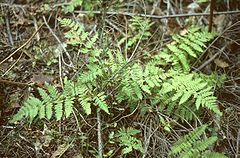Dryopteridaceae
| Dryopteridaceae | |
|---|---|
 |
|
| Dryopteris carthusiana | |
| Scientific classification | |
| Kingdom: | Plantae |
| Division: | Pteridophytes |
| Class: | Polypodiopsida / Pteridopsida (disputed) |
| Order: | Polypodiales |
| (unranked): | Eupolypods I |
| Family: |
Dryopteridaceae Herter 1949 (nom. cons.) |
| Subfamilies | |
|
|
The Dryopteridaceae are a family of leptosporangiate ferns in the order Polypodiales. They are known colloquially as the wood ferns. They comprise about 1700 species and have a cosmopolitan distribution. They may be terrestrial, epipetric, hemiepiphytic, or epiphytic. Many are cultivated as ornamental plants. The largest genera are Elaphoglossum (600), Polystichum (260), Dryopteris (225), and Ctenitis (150). These four genera contain about 70% of the species. Dryopteridaceae diverged from the other families in eupolypods I about 100 million years ago.
The rhizomes are often stout, creeping, ascending, or erect, and sometimes scandent or climbing, with nonclathrate scales at apices. Fronds are usually monomorphic, less often dimorphic, or sometimes scaly or glandular, but less commonly hairy. Petioles have numerous round, vascular bundles arranged in a ring, or rarely as few as three; the adaxial bundles are largest. Veins are pinnate or forking, free to variously anastomosing; the areoles occur with or without included veinlets; sori are usually round, acrostichoid (covering the entire abaxial surface of the lamina) in a few lineages; usually indusiate, or sometimes exindusiate. Indusia, when present, are round-reniform or peltate. Sporangia have three-rowed, short to long stalks; spores arereniform, monolete, perine or winged.
...
Wikipedia
